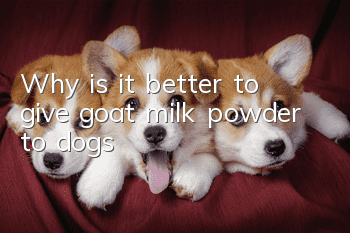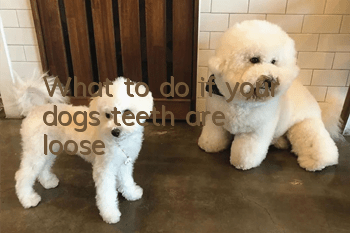What causes dogs to chew on walls and what should I do?

Recently I discovered that my dog likes to chew on walls. What is going on? Is it because the dog is naughty or is it for other reasons? Dogs sometimes eat soil, dig at walls, lick the ground, bite stones, etc. In this case, it should be It's pica, which is a lack of trace elements. It mostly occurs in puppies, especially when the dog's nutrition is imbalanced or teeth grow or change.
Generally, dogs lacking trace elements will show symptoms such as: chewing walls, biting tails, licking the ground, eating poop, etc. Although some of the above situations are normal for dogs, if parents decide to supplement trace elements for their dogs, It is recommended to extract it from food as much as possible. If you feel that this supplement is too troublesome and difficult to match, it is recommended to use Gudenjin Vitamin, which is specially designed to supplement vitamins, minerals and trace elements for dogs.
At the same time, dogs can also be fed trace elements to pets. Coupled with dog chews, toys, etc., to divert the dog's target, these bad habits can be corrected quickly.
The absorption rate of trace elements in different foods varies greatly. Some foods can be eaten regularly and in large amounts, while others are not easy to eat, or you can only eat a little. Taking too much supplements will cause poisoning, but natural foods will not cause poisoning. But the absorption rate decreases if you eat too much, so again, moderation is important.
Meat
They are a good source of iron and zinc, and are also rich in trace elements such as copper, manganese, and selenium. The most important thing is that meat contains heme iron. The best food for dogs is lean meat, chicken, etc. As for meat bones, if it is a small or medium-sized dog, you should try to avoid eating small bones such as chicken and sheep to avoid scratches in the body.
Aquatic products
Aquatic products are a good source of almost all trace elements, and seafood is particularly rich in iodine and selenium. But dogs should be very cautious when eating fish. As for marine molluscs or shellfish, although they are rich in comprehensive trace elements and are excellent dietary supplements for humans, they are restricted areas for dogs. To eat fish, the spines should be picked clean. If very cautious parents are unwilling to feed fish, they can make up for it with beans and whole grains.
Nuts
Among plant foods, nuts are a treasure trove of trace elements. Whether it is walnuts, hazelnuts, sesame seeds, peanuts, or melon seeds, they are rich in zinc, iron, manganese, selenium and other elements. However, dogs cannot eat too much because the calories of nuts are too high, which is different from humans (in fact, humans cannot eat too much of many fruits). Small amounts go a long way.
Beans
Beans are actually quite rich in trace elements. Although not as good as nuts, they are much more abundant than rice and white flour and have much lower calories. Disadvantages: The main problem with beans is that the absorption rate of trace elements is relatively low, because there are relativelyToo much "phytic acid" will hinder the absorption of minerals. The advantage is that in addition to supplementing trace elements, it can also supplement enough protein and B vitamins.
Coarse grains
Many experienced parents know that occasionally eating whole grains is very beneficial to dogs. This is why we often hear that a certain mother steams nutritious buns for her dog babies ^ ^ Whole grains that dogs can eat include corn flour, Oatmeal, millet flour, etc. For humans, the darker the color of the whole food, the better, but this is not the case for dogs. The darker the color, the less the intake.
Vegetables
Vegetables have too much water, so they appear to have low trace element content. In fact, if calculated based on dry weight, it is very rich in nutrients. They can not only provide a large amount of elements such as potassium and magnesium, but also provide some elements such as iron, zinc, manganese, and selenium.
You can eat: Carrots (also included in vegetables, but it should be noted that they must be sliced or shredded, and then fried for 15 minutes or steamed for 20 minutes, because only 30% of the nutrients of raw carrots can be absorbed) If cut into shreds and fried for 15 minutes, it can reach 90%, and steamed with meat for 20 minutes, it can reach 97%) Garlic: Eating less garlic is absolutely harmless to dogs and has many benefits. Although garlic is also a spicy food, its characteristics are completely different from those of onions. and contains allicin and rich minerals. Puppies between 3 and 8 months old take half a flap a day, and adult dogs take one flap a day.
Green leafy vegetables such as cabbage, celery, coriander, etc. are not listed one by one.
Finally, many Teddy parents confuse trace elements and vitamins, thinking that they are nutrients that are rarely found in food and are easily lacking in Teddy’s diet. Trace elements are not easily lost by heat (vitamin C is afraid of heat, vitamin B2 is afraid of light, and vitamin A is afraid of oxidation). However, relative minerals will be lost if you peel off the skin, throw away the outer leaves, or make the rice flour very white. There are many trace elements, because the closer to the center, the lower the nutrient content.
- Which police dog is more powerful? A dog suitable for being a police dog!
- What should you pay attention to when training a red-maned dragon lizard? A must-read for beginners!
- How to train Caucasian dogs to stand
- What should I do if my dog doesn’t take medicine? How can I make my dog take medicine obediently?
- How to train a dog to follow? Train your companion the way the Dog Whisperer does!
- Can Teddy eat watermelon seeds?
- How to train puppies to go to the toilet at designated places
- Do you know the origin of the Dogo?
- The difference between Greyhound and Greyhound_How much does a Greyhound cost and what is its IQ?
- What to do if your dog refuses to take medicine



